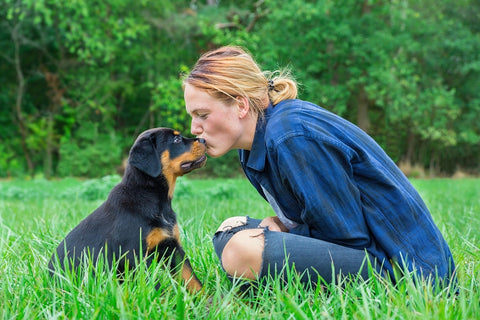Can dogs get depressed? What are the signs of dog depression? If my dog is struggling with depression, what do I do? Like humans, your four-legged best friend may suffer from anxiety or depression. A big change in a dog’s life or a distressing event is usually the cause of depression. As a pet owner, what are the warning signs of dog depression, and what can you do to help? Dog ID Collar answers the prior questions and more.
First, before Dog ID Collar discusses the warning signs of dog depression, let’s dive into the causes.
Causes of Depression in Dogs
Depression in dogs may be due to a medical condition. Contact your veterinarian as soon as you notice signs of dog depression. Rule out the physical causes of depression in your four-legged best friend before you consider the following emotional causes.

Like we mentioned before, major life changes and tragic events can cause canine depression. The most common cause of dog depression is the loss of a pet owner or animal companion. Dogs may also feel the grief of those close to them like owners or other members of the household, picking up on their depression.
Remember, dogs grieve just like the rest of us. Pay close attention to your furry best friend if the loss comes their way.
Major life changes that may lead to depression and anxiety in your pet include a move to a new house, a significant change to their routine, or introducing a new human or pet into the household. Maybe you’ve accepted a new job or have switched from the day shift to the night shift. Dogs are affected by these changes more often than you may think, so Dog ID Collar recommends being on the lookout for signs of dog depression.
7 Warning Signs of Dog Depression
Hiding
Hiding is one of the top warning signs of dog depression. If your canine is around the family less and less, maybe even for the better part of the day, your dog may be depressed. With dogs being natural pack animals, being around family is normal behavior.
Changes in Appetite
Changes in your dog’s eating habits are signs of dog depression. Eating as if their life depends on finishing every bite of their food along with a loss of appetite are both signs to pay attention to. Sadly, a lack of appetite can also be a sign of serious medical issues. Dog ID Collar recommends contacting your vet if your furry best friend is experiencing appetite loss.
Sleeping Habits
The average adult dog sleeps approximately 12 to 14 hours per 24-hour period. Puppies tend to sleep 18-20 hours per 24-hour period. If your adult dog is beginning to sleep like a puppy, they may be suffering from depression. On the flipside of excessive sleep, dogs may also suffer from insomnia. If your dog suddenly has the inability to sleep, it may be time to call the vet or start treating your pet for depression.

Aggressive Behavior
Is your pet suddenly expressing newfound aggression? Research shows aggression is part of the common signs of dog depression. Your canine may be a big softie but if he is suddenly aggressive towards other dogs or humans on walks or during playtime there may be an issue. Depression and anxiety can cause abrupt behavior changes in humans as well as dogs.
Consistent Licking
Veterinary health expert, Dr. Gary Richter says, "Most people are not aware, but excessive licking (or chewing) can be a way of self-soothing.” Incessant licking may be a sign your pet is experiencing anxiety or depression. Remember, excessive licking is also a sign of bacterial infections, eczema, joint pain, and dry skin. In addition to the other warning signs of dog depression listed, constant licking may be a warning sign to pay attention to.
Other Warning Signs of Dog Depression - Lethargy
Lethargic tendencies and an unwillingness to play are symptoms of dog depression. Exhibiting low activity levels may be signs of many other medical issues, but depression is one of these issues. Check with your veterinarian if you start seeing high levels of lethargy.
New Vocalizations
Additional warning signs of dog depression include new vocalizations like growling, howling and whining. Long, mournful howls may be a sign your dog is injured or sadly, suffering from depression. Along with howling, if your dog’s greeting signs have turned from sweet kisses to aggressive growling, there may be cause to worry.
So, as a dog owner, how do you help your furry best friend suffering from depression? Dog ID Collar gathered treatments and solutions for dogs with depression below.
Treatments and Solutions for Dogs with Depression

Symptoms and warning signs of dog depression can be scary for an owner to hear and see, but there is a light at the end of the tunnel. John Ciribassi, past president of the American Veterinary Society of Animal Behavior, says, “Most dogs bounce back from depression within a few days to a few months with just a little extra TLC.” Give extra attention to your dog and keep your furry best friend engaged. Extra walks in the sunshine, car ride with the windows down, and more cuddle time could be just what your pet needs to overcome their depression and anxiety.
The cause of depression may directly correlate with the solution needed. Getting another pet can help with dogs who have suffered the loss of a companion and are suffering from depression. Dog ID Collar recommends dealing with the problem before the problem becomes too big. As mentioned before, contact your veterinarian when symptoms start to worry you.
After trying the treatments listed above and your dog still seems low, there are medications to help. Visiting the vet is the first step to take, and keep in mind, many dogs recover from their anxiety and depression in a short period of time. We hope our list of top warning signs of dog depression helps you with your pet. Dog ID Collar wishes you and your four-legged best friend a speedy recovery if struggling with depression.
